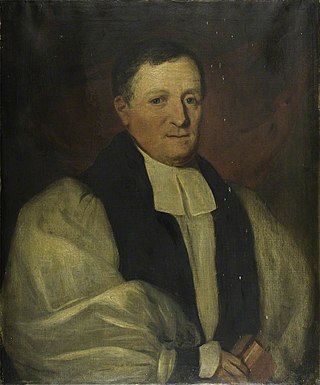Related Research Articles

Charles Agar, 1st Earl of Normanton, was an Anglo-Irish clergyman of the Church of Ireland. He served as Dean of Kilmore, as Bishop of Cloyne, as Archbishop of Cashel, and finally as Archbishop of Dublin from 1801 until his death.

The Rt. Rev. and Hon. Richard Ponsonby (1772–1853) was an Irish clergyman who held high office in the Church of Ireland.

Thomas Barnard was an Anglican clergyman who served in the Church of Ireland as Bishop of Killaloe and Kilfenora (1780–1794) and Bishop of Limerick, Ardfert and Aghadoe (1794–1806).
Thomas Lindsay, D.D., B.D., M.A (1656–1724) was an Anglican clergyman who served in the Church of Ireland as the Dean of St. Patrick's Cathedral, Dublin, Bishop of Killaloe, Bishop of Raphoe and finally Archbishop of Armagh.

Joseph Deane Bourke, 3rd Earl of Mayo was an Irish peer and cleric who held several high offices in the Church of Ireland including Bishop of Ferns and Leighlin (1772–82) and Archbishop of Tuam (1782–94).

Sir John Hotham, 9th Baronet, DD (1734–1795) was an English baronet and Anglican clergyman. He served in the Church of Ireland as the Bishop of Ossory from 1779 to 1782 and Bishop of Clogher from 1782 to 1795.
Randolph Barlow, was made Pembroke College fellow at Cambridge University in 1593; attained Master of Arts in 1594; awarded Doctor of Divinity in 1600; took holy orders and later served in the Church of Ireland as the Archbishop of Tuam from 1629 to 1638.
Robert Howard, D.D. was an Anglican prelate who served in the Church of Ireland as the Bishop of Killala and Achonry (1727–1730) and Bishop of Elphin (1730–1740).
Thomas Bayly was a seventeenth century Anglican bishop in Ireland.
Arthur St. George, a graduate of Trinity College, Dublin and the Chancellor of Clogher, was a Seventeenth century Irish Anglican priest: he was Dean of Ross, Ireland from 1743 until 1772.
Anthony Martin was an Anglican priest in Ireland during the first half of the 17th-century.
Thomas Ram was an Anglican priest in the early seventeenth century.
Henry Gervais was an Anglican priest in Ireland during the 18th century.
Wensley Bond (1742–1820) was an Irish Anglican priest in the second half of the 18th century and the first two decades of the 19th.
Anthony Cope was a seventeenth-century Irish Anglican priest.
James Dickson was an Irish Anglican Dean.
Daniel Neyland (1618–1688) was an Irish Anglican priest in the 17th century.
Thomas Crofton was an Irish Anglican priest in the 17th century.
John Wardlaw was an Irish Anglican priest..
William Digby was an Irish Anglican priest.
References
- ↑ "History of the Church of Ireland: From the revolution to the union of the Churches of England and Ireland, January 1, 1801" Mant, R: London, J.W. Parker, 1840
- ↑
 "Fuller, Thomas". Dictionary of National Biography . London: Smith, Elder & Co. 1885–1900.
"Fuller, Thomas". Dictionary of National Biography . London: Smith, Elder & Co. 1885–1900. - ↑ Foster, Joseph (1892). Alumni Oxonienses: The Members of the University of Oxford, 1500–1714. Dublin: University of Oxford. pp. 510–541. ISBN 978-1-85506-843-8.
- ↑ Cotton, Henry (1849). The Province of Munster. Fasti Ecclesiae Hiberniae: The Succession of the Prelates and Members of the Cathedral Bodies of Ireland. Vol. 3. Dublin: Hodges and Smith. pp. 330–331.
- ↑ Cotton, Henry (1849). The Province of Munster. Fasti Ecclesiae Hiberniae: The Succession of the Prelates and Members of the Cathedral Bodies of Ireland. Vol. 3. Dublin: Hodges and Smith. pp. 299–300.
- ↑ "Handbook of British Chronology" By Fryde, E. B;. Greenway, D.E;Porter, S; Roy, I: Cambridge, CUP, 1996 ISBN 0-521-56350-X, 9780521563505
- ↑ Royalists and Royalism during the Interregnum edited by: Jason McElligott, David L. Smith, Manchester University Press, 2010
- ↑ "A New History of Ireland" Moody, T.W; Martin, F.X; Byrne, F.J;Cosgrove, A: Oxford, OUP, 1976 ISBN 0-19-821745-5
- ↑ "Rock of Cashel Co. Tipperary" by Duchas The Heritage Service
- ↑ "Fasti ecclesiæ hibernicæ: the succession of the prelates in Ireland" Cotton, H Dublin, Hodges & Smith, 1860 Vol 1 p14